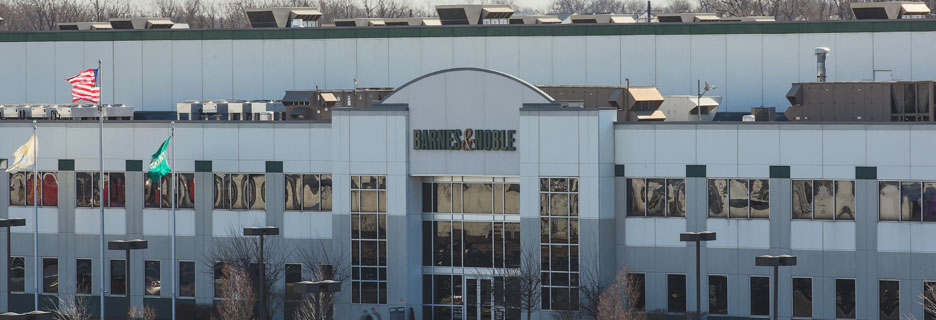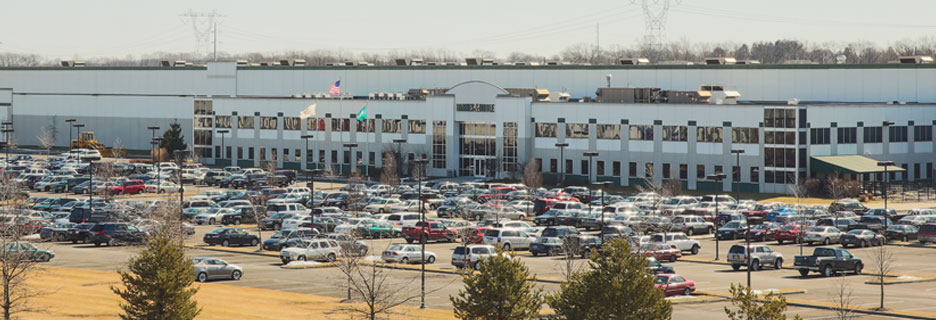Search Site
Back to Menu

Barnes & Noble Case Study
Executive Summary
Since the recession of 2008, the real estate sector has experienced an uneven recovery. While West Coast markets rebounded relatively quickly, many in the New England and Mid-Atlantic regions have taken longer to stabilize. As late as 2013, the New Jersey real estate market remained flat, despite its impressive logistical advantages. Signs of growth in industrial real estate, however, point toward the market’s bright future, with tenants and investors eyeing northern New Jersey’s proximity to population centers, coastal ports and extensive transportation infrastructure.
The Barnes & Noble distribution facility in Monroe, NJ, is a prime example of the market’s viability as an industrial real estate hub. Developed in 2005, the built-to-suit was designed primarily to distribute books and other products, and provide back-end server support for the bookseller’s Nook tablets. This case study focuses on CenterPoint Properties’ acquisition of the Barnes & Noble distribution facility, including the investment’s short and long-term benefits and future potential for the property.

Judging a Book (Distribution Facility) by More than Its Cover
The brick-and-mortar bookstore hemorrhage brought on by e-commerce giants like Amazon claimed a number of major chains. In recent quarters, Barnes & Noble’s store sales have flattened – rather than plummeted – but the brand still struggles against stiff competition from Apple and Amazon in the digital reader arena1. Despite the firm’s financial troubles, their distribution center in Monroe was a state-of-the-art investment. Boasting 1.15 Million SF, expandable 675-car parking and 115 exterior doors, dual grid power, and access to a third of the nation’s population within 10 hours, the facility has all the hallmarks of a top-tier e-commerce hub. However, Barnes & Noble’s shaky bottom line and lease extending to 2020 turned off many potential buyers.
Cushman & Wakefield brought the property to market in the middle of 2012, but it attracted few quality bids. Many investors believed it was only a matter of time before e-commerce rendered Barnes & Noble’s business model obsolete. In December 2012, CenterPoint examined the location more carefully, noting its similarities to a build-to-suit Amazon recently developed on the West Coast.
In particular, the facility’s robust power and fulfillment infrastructure signaled potential to support a wide range of tenants. The property’s adaptability played a prominent role in CenterPoint’s decision to invest. The location enjoyed all of the advantages necessary to secure demand down the road.

The ROI of Adaptability
CenterPoint completed the $83 million acquisition of the Barnes & Noble facility in February 2013. Over the short-term, CenterPoint benefits from a high rate of return on their investment at 7.4%—150 basis points higher than the market average for Class A buildings. Under normal conditions, a comparable property would generate revenue within the 5% range.
The long-term prospects for the property are even brighter, with a variety of factors sustaining its value even after Barnes & Noble’s lease expires:
- Property Size and Scope: The already massive Barnes & Noble facility presents multiple options for further expansion. The car parking lot can be redeveloped to hold up to 1,600 vehicles, while the exterior doors are also expandable. Further, the property can accommodate an expansion of 100,800 SF, adding to its more than one million existing square feet. The property offers vast repurpose potential, including the option to split up the one-tenant facility for multiple distribution centers, Public-Private-Partnerships, or other arrangements.
- Transportation Advantage: The site’s proximity to major domestic markets, and its access to continental and international transportation infrastructure, are its strongest sources of value. Located just off the New Jersey turnpike exit 8A, the facility is 35 miles from Manhattan, 60 miles from Philadelphia, and only half an hour from the ports of New York and New Jersey. This location could offer future logistics or retail tenants tangible cost savings: drayage costs from the ports to the Monroe property total approximately $429 per container, compared to $483 for a facility off of exit 7A, or $611 for the regional submarket Allentown, Pennsylvania.

Putting Down Roots in a Fertile Region
CenterPoint’s acquisition of the Barnes & Noble facility in Monroe provides a healthy revenue stream in the short-term, and opportunity for future expansion in the burgeoning New Jersey market. With goals to acquire 15 Million square feet throughout the East Coast region over the next three years, investments of this scope are critical to fleshing out a profitable Mid-Atlantic portfolio. Looking ahead, additional property around exit 8A, as well as the Meadowlands are particular areas of interest, given the former’s access to East Coast population centers and the latter’s immediacy to the George Washington Bridge.
E-commerce is the driver du jour for many recent real estate moves, but this trend is truly a supporting point to the importance of location. CenterPoint’s investment strategy is primarily concerned with where a property is located, especially its distance from port-focused transportation infrastructure and proximity to population hubs. Functionality and appearance, while still significant factors, take a backseat to location, especially given the varying demands of clients and ability to refit facilities as required. With these timeless advantages in the Mid-Atlantic market’s favor, New Jersey can shed its status as a post-recession late bloomer and solidify its reputation as an industrial real estate nexus.
Sources
Subscribe
Microsite Request